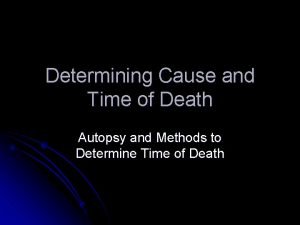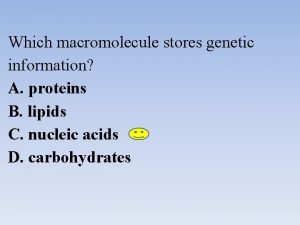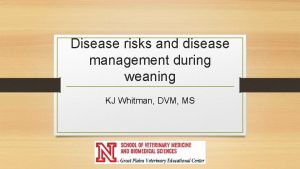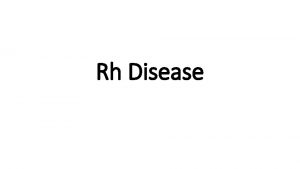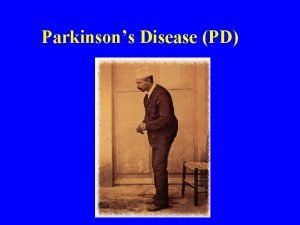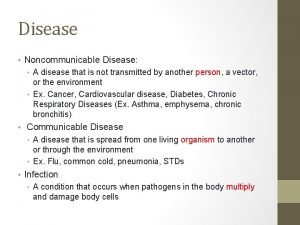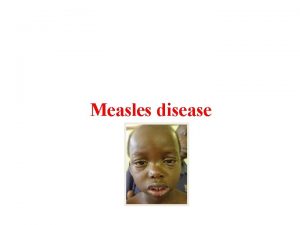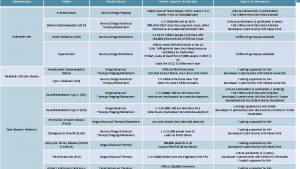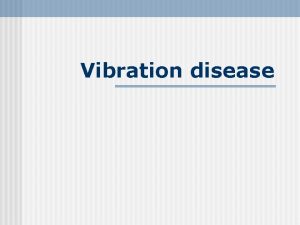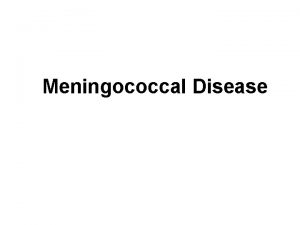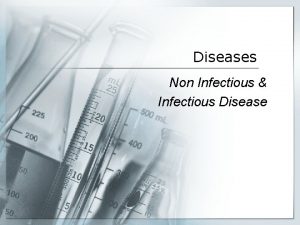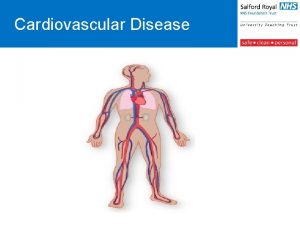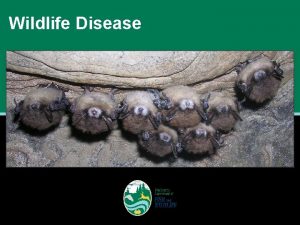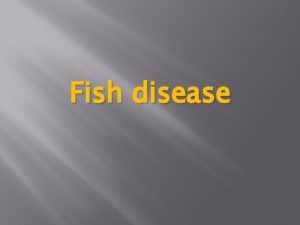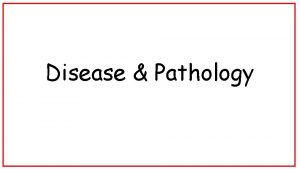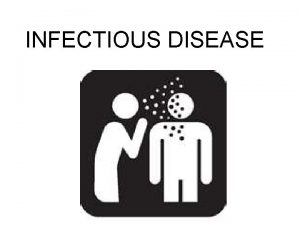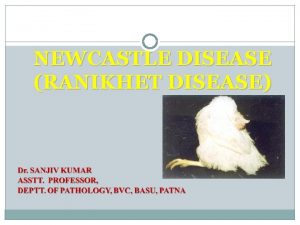The Disease Which Raged During the Spring of


























- Slides: 26


The Disease Which Raged During the Spring of 1805 Gaspard Vieusseux It commences suddenly with prostration of strength, often extreme: the face is distorted, the pulse feeble. There appears a violent pain in the head, especially over the forehead; then there comes pain of the heart or vomiting of greenish material, stiffness of the spine, and in infants, convulsions. In cases which were fatal, loss of consciousness occurred. The course of the disease is very rapid, termination by death or by cure. In most of the patients who died in 24 hours or a little after, the body is covered with purple spots at the moment of death or very little time afterward.

Epidemiology • In the United States, approximately 3000 sporadic cases occur each year. • Nasopharyngeal carriage rate: 3 -15% • Belt across sub-Saharan Africa: 1% • In Taiwan, 81 sporadic cases occurred from 1992 to 2000 including 8 fetal cases. • In 2001, 30 sporadic cases occurred including 6 fetal cases.

Microbiology Family Neisseriaceae contains five genera: • Neisseria • Kingella • Eikenella • Simonsiella • Alysiella.

Genus of Neisseria • • N. gonorrhoeae N. meningitidis N. kochii N. sicca N. lactamica N. subflava N. flavescens • N. mucosa • N. cinerea • N. polysacchreae • N. elongata • N. macacae • N. canis • N. dentrificans.

N. meningitidis • gram-negative diplococcus, kidney beans, encapsulated • facultatively anaerobic, catalase (+) and oxidase (+) • autolyse when exposed to drying or sunlight • 13 serogroups currently are recognized: A, B, C, D, H, I, K, L, X, Y, Z, W 135, and 29 E.

Chemical Structure of Group-Specific Polysaccharide Capsules of Meningococci

• Serogroups A, B, and C account for more than 90 % of meningococcal disease worldwide. • Serogroup A: periodic epidemics in developing countries, is responsible for only 3 % of in the United States. • Serogroup B: sporadic disease but occasionally is associated with outbreaks. • Serogroup C: associated with numerous outbreaks in the United States, Canada, and Europe. • Serotype Y: has been associated with meningococcal pneumonia in military recruits.

• The germ is spread by direct contact with secretions from the nose and throat, such as by kissing, coughing, sneezing, and sharing of cigarettes, drinks, and food. • Prevalence : winter and spring • Incubation period: 1 -10 days, most < 4 days

Risk factors • • • inversely to age upper respiratory pathogens smoke and passive smoke family members late complement component deficiencies alternate pathway (properdin) deficiency

Clinical manifestations • • Serious/Invasive Disease Conjunctivitis Pharyngitis Meningococcal Pneumonia Meningococcal Pericarditis Mesenteric Adenitis and Peritonitis Infections of the Genitourinary Tract Chronic Meningococcemia

Symptoms and Signs • Symptoms are usually sudden and initially are like the flu: fever, feeling generally unwell, headache, vomiting, and in some cases a stiff neck. • People with this disease are visibly sick and may be confused, excited, or drowsy. • Sometimes a reddish-purple rash that may look like bruises appears.

• The rash is flat and smooth, does not itch, and may spread quickly once it starts. • In rare cases, the symptoms are followed by lowered blood pressure, shock, delirium, sudden extreme weakness, coma, and death. • Because the disease spreads quickly in the body, it is important to see a physician immediately if symptoms suggesting meningococcal disease develop.

Signs and Symptoms in Serious Meningococcal Disease

Laboratory findings • • • Leukopenia <5000/ mm 3 : 21 % Thrombocytopenia : 14 % Hyponatremia(SIADH): 7% DIC Acidosis Liver function

Diagnosis • Culture: Gold standard Blood culture alone is positive about 50 % • Gram stain: Rapid diagnosis • Counterimmunoelectrophoresis and latex agglutination: Cross reaction to E. coli or bacillus • Polymerase chain reaction : newer tests Specificity : 91 %

Case Definitions for Invasive Meningococcal Disease

Therapy • For penicillin-susceptible meningococcemia or meningitis, iv penicillin G, 250, 000 units/kg/day every 4 hours for 7 days. • Third-generation cephalosporins, ceftriaxone (100 mg/kg/day iv in two divided doses) and cefotaxime (200 mg/ kg/day iv in four divided doses • Steroid therapy is controversal

Presenting Features of Meningococcal Infection Associated with Poor Prognosis • Presence of petechiae < 12 hours before admission • Presence of hypotension (systolic <70 mm Hg) • Absence of meningitis (<20 WBC/mm 3) • Peripheral white blood cell count <10, 000/mm 3 • Erythrocyte sedimentation rate <10 mm/hour Stiehm, E. R. et al J. Pediatr 1966

Additional prophylactic • Rifampin, 10 mg/ kg/dose (maximum, 600 mg/dose) every 12 hours for 2 days • Single ceftriaxone (125 mg IM for children < 12 years of age or 250 mg IM for those > 12 years of age)

Disease Risk for Contacts of Index Cases of Invasive Meningococcal Disease

Chemoprophylaxis

Recommendations for Administration of Meningococcal Vaccine



 Giduk
Giduk Months of spring
Months of spring Bharathi viswanathan
Bharathi viswanathan Methods for determining time of death
Methods for determining time of death Which macromolecule stores genetic information
Which macromolecule stores genetic information Hát kết hợp bộ gõ cơ thể
Hát kết hợp bộ gõ cơ thể Frameset trong html5
Frameset trong html5 Bổ thể
Bổ thể Tỉ lệ cơ thể trẻ em
Tỉ lệ cơ thể trẻ em Voi kéo gỗ như thế nào
Voi kéo gỗ như thế nào Tư thế worms-breton
Tư thế worms-breton Hát lên người ơi alleluia
Hát lên người ơi alleluia Môn thể thao bắt đầu bằng từ đua
Môn thể thao bắt đầu bằng từ đua Thế nào là hệ số cao nhất
Thế nào là hệ số cao nhất Các châu lục và đại dương trên thế giới
Các châu lục và đại dương trên thế giới Công thức tính độ biến thiên đông lượng
Công thức tính độ biến thiên đông lượng Trời xanh đây là của chúng ta thể thơ
Trời xanh đây là của chúng ta thể thơ Mật thư tọa độ 5x5
Mật thư tọa độ 5x5 Phép trừ bù
Phép trừ bù độ dài liên kết
độ dài liên kết Các châu lục và đại dương trên thế giới
Các châu lục và đại dương trên thế giới Thơ thất ngôn tứ tuyệt đường luật
Thơ thất ngôn tứ tuyệt đường luật Quá trình desamine hóa có thể tạo ra
Quá trình desamine hóa có thể tạo ra Một số thể thơ truyền thống
Một số thể thơ truyền thống Cái miệng bé xinh thế chỉ nói điều hay thôi
Cái miệng bé xinh thế chỉ nói điều hay thôi Vẽ hình chiếu vuông góc của vật thể sau
Vẽ hình chiếu vuông góc của vật thể sau Biện pháp chống mỏi cơ
Biện pháp chống mỏi cơ



